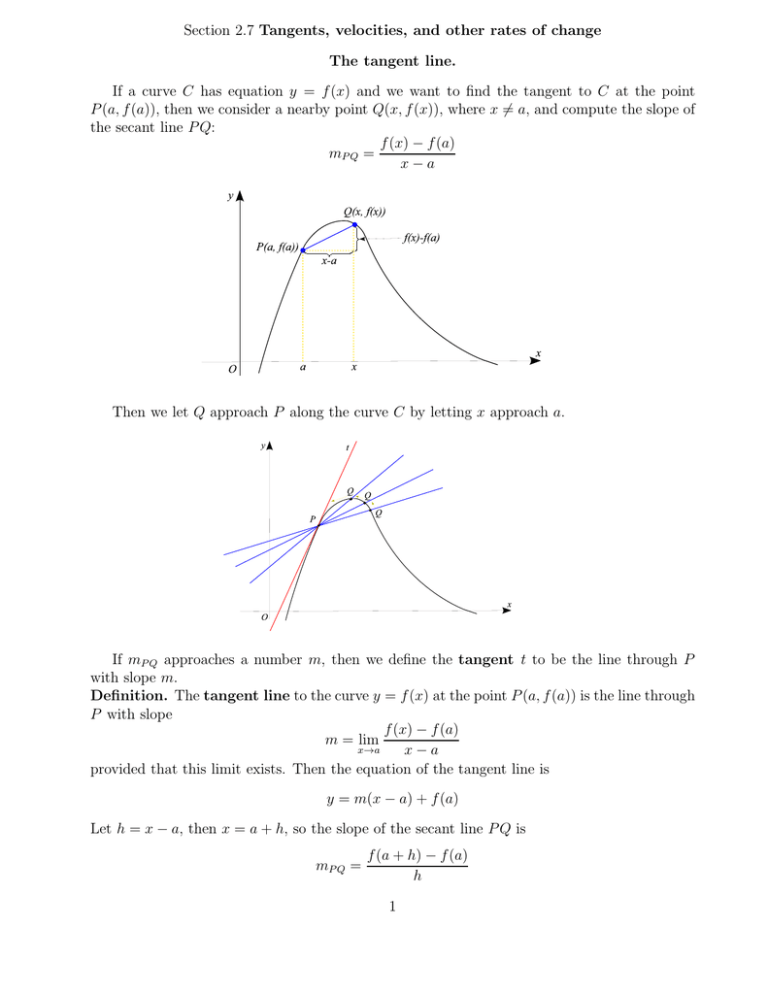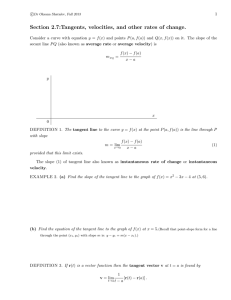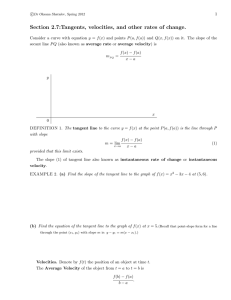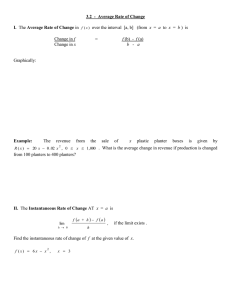Section 2.7 Tangents, velocities, and other rates of change
advertisement

Section 2.7 Tangents, velocities, and other rates of change The tangent line. If a curve C has equation y = f (x) and we want to find the tangent to C at the point P (a, f (a)), then we consider a nearby point Q(x, f (x)), where x 6= a, and compute the slope of the secant line P Q: f (x) − f (a) mP Q = x−a Then we let Q approach P along the curve C by letting x approach a. If mP Q approaches a number m, then we define the tangent t to be the line through P with slope m. Definition. The tangent line to the curve y = f (x) at the point P (a, f (a)) is the line through P with slope f (x) − f (a) m = lim x→a x−a provided that this limit exists. Then the equation of the tangent line is y = m(x − a) + f (a) Let h = x − a, then x = a + h, so the slope of the secant line P Q is mP Q = f (a + h) − f (a) h 1 Then the slope of the tangent line becomes f (a + h) − f (a) h→0 h m = lim Example 1. Find the equation of the tangent line to the curve y = 2 √ 2x − 3 at the point (2,1). Tangent vectors Let ~r(t) =< x(t), y(t) > be a vector function. Problem. Find a tangent vector to a curve traced by ~r(t) at the point P corresponding to the vector ~r(a) =< x(a), y(a) >. The tangent vector to a curve traced by ~r(t) at the point P corresponding to the vector ~r(a) =< x(a), y(a) > is given by 1 1 [~r(t) − ~r(a)] = lim [~r(a + h) − ~r(a)] t→a t − a h→0 h ~v = lim Then the equation of the tangent line to a curve traced by ~r(t) at the point P corresponding to the vector ~r(a) =< x(a), y(a) > is given by ~ L(t) = ~r(a) + t~v Example 2. Find the tangent vector and parametric equations for the line tangent to the curve ~r(t) =< 1 − 4t, 2t − 3t2 > at the point P (−11, −21). 3 Velocity. Suppose an object moves along a straight line according to an equation of motion s = f (t), where s is the displacement of the object from the origin at time t. Function f is called the position function of the object. average velocity = f (a + h) − f (a) displacement = time h Then the velocity or instantaneous velocity at time t = a is f (a + h) − f (a) h→0 h v(a) = lim Example 3. The displacement of an object moving in a straight line is given by s(t) = 1 + 2t + t2 /4 (t is in seconds). (a) Find the average velocity over the time period [1,3] (b) Find the instantaneous velocity when t = 1 4 Example 4. The object is moving upward. Its height after t sec is given by h(t) = 58t − 0.83t2 (a) What is the maximum height reached by the object? (b) Find the instantaneous velocity at t = 1 Suppose an object moves in the xy-plane in such a way that its position at time t is given by the position vector ~r(t) =< x(t), y(t) >. average velocity = 1 ~r(a + h) − ~r(h) = [~r(a + h) − ~r(a)] h h The instantaneous velocity ~v (t) at the time t = a is ~r(a + h) − ~r(a) h→0 h ~v (a) = lim The speed of a particle is defined to be the magnitude of the velocity vector. 5 Example 5. If a ball is thrown into the air with a velocity of 10~ı + 30~ ft/s, its position after t seconds is given by ~r(t) = 10t~ı + (30t − 16t2 )~ (a) Find the velocity of the ball when t = 1 (b) Find the speed of the ball when t = 1 Other rates of change. Suppose y is a quantity that depends on another quantity x or y = f (x). If x changes from x1 to x2 , then the change in x (also called the increment of x) is ∆x = x2 − x1 and the corresponding change in y is ∆x = f (x2 ) − f (x1 ) The difference quotient f (x2 ) − f (x1 ) ∆y = ∆x x2 − x1 6 is called the average rate of change of y with respect to x over the interval [x1 , x2 ]. The instantaneous rate of change of y with respect to x at x = x1 is equal to f (x2 ) − f (x1 ) ∆y = lim ∆x→0 ∆x→0 ∆x x2 − x1 lim Example 6. The population (in thousands) of a city from 1990 to 1996 is given in the following table year 1990 1991 1992 1993 1994 1995 1996 P (in 1000s) 105 110 117 126 137 150 164 (a) Find the average rate of growth from 1992 to 1996 (b) Estimate the instantaneous rate of growth in 1993 7



